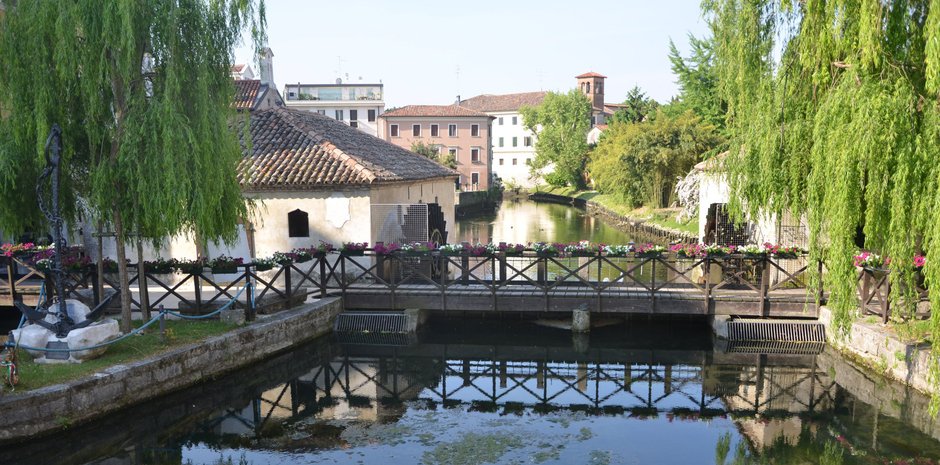
From the Eastern Veneto, the city of Portogruaro was born symbolically on 10 January 1140, with an act written by the bishop of Concordia Sagittaria.
Along the banks of the river Lemene houses, warehouses for agricultural activities, a river dock and commercial laboratories are established. Over time the bourgeoisie consolidated and here builds houses in Gothic and Romanesque style, as well as imposing decorated palaces which still today represent the main attraction of the historical city center. There are countless beauties of the city of Eastern Venice, from the fourteenth century Town Hall with the typically Gothic facade to the ancient Arco del Fondaco, from the mills caressing the waters of the Lemene river to the intimacy of some of its calli echoing the Venetian flavor. The city of Portogruaro represents the right compromise between tradition and innovation, a place of rest and discovery.
Concordia was founded in 42 B.C. and formerly called Iulia Concordia. Important Roman center developed between the Via Postumia and the Via Annia, Concordia Sagittaria thrives over the centuries, and draws strength and inspiration from the waters of its river: the Lemene (ancient Reatinum flumen). Concordia Sagittaria is today a charming town able to embrace the history of Rome with modernity, where the right balance is achieved in the magnificence of the Cathedral of Santo Stefano with the sinuous cycle-pedestrian paths that surround it.
We therefore visit the frescoed Baptistery that frames the Cathedral of the fourth century, discover the beauty of the ancient remains of the Basilica Apostolorum Maior, let us be enchanted by the surrounding nature and superb typical cuisine of fish and Doc Lison-Pramaggiore wines. A stay in the area of Caorle also means immersing oneself in the history and culture of real cities of art as in the case of Concordia Sagittaria (20 km from us), an important paleoveneto center that in 42 BC. became a Roman colony with the name of Julia Concordia.
With the threat of barbarian invasions, the colony in the III century AD became a stronghold thanks to the installation of an arrow factory, the sagittae. Only around the eleventh century it was reborn as a real town, a fiefdom and a diocesan seat dependent on the Patriarch of Aquileia. Among the monuments of the Middle Ages, the Romanesque-Byzantine Baptistery with a well-preserved fresco inside and the adjacent bell tower should be mentioned.
Starting from the museum rooms of the sixteenth-century Palazzo Municipale in Via Roma, on the ground floor an interesting and clear map reconstructs the Roman city and highlights the sites that can be visited. To admire the various findings from the necropolis and residential areas of the ancient city, such as the solar clock. Entry is free. The rooms can be visited on Saturdays and Sundays, the other days by reservation only, by contacting the following number +39 0421 270360 or email address comune@concordiasagittaria.ve.it.
Turning into Via delle Terme, you can see a section of the walls and the remains of a thermal complex. Continuing the route, we reach the mosaics of the domus of the Signini, in the homonymous park, and two Roman wells that give the name to the street itself. Crossing the park of the Signini, a hedge of box marks the excavation of the ancient theater; from here you get to the Roman bridge of Via San Pietro, with three arches partly preserved.
In Piazza Celso Costantini, under the Cathedral of Santo Stefano you can visit the fourth-century paleochristian complex that includes the Trichora, with attached funerary enclosures and paved courtyard, and the Basilica Apostolorum Maior, with mosaic floor. On the northern side of the area you can see a segment of the Roman consular road, Via Annia, perfectly preserved. A curiosity: by purchasing the entrance ticket to the archaeological area you can also take advantage of the entrance to the Concordiese Museum of Portogruaro, valid for one month. Here the route suggested by the Superintendence for Cultural Heritage. Finally, the Romanesque-Byzantine Baptistery, the only example of the eleventh century to preserve, within it, the original pictorial decoration; It is located next to the medieval bell tower.
And if you are still not tired, know that many finds found in the excavation campaigns are also exhibited at the National Concordiese Museum of Portogruaro that from Concordia Sagittaria can also be reached on foot or by bike, covering a few km, thanks to a pedestrian-cycle path along the Lemene river.
